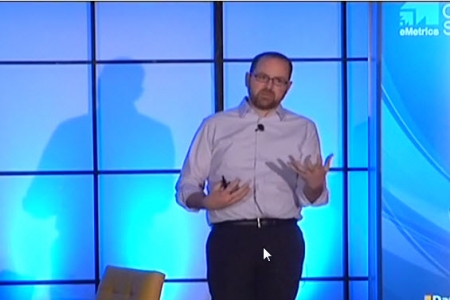“What I really want to talk about this other passion of understanding decision-making and understanding why it is that people do what they do – and if people make a decision, then are they better off for that choice that they’ve made?”
Nicholson’s passion is understanding decision-making, why people do what they do, and whether people are better off after making a decision.
This divides into three categories:
- How people make decisions for themselves
- Getting people to make the decision that helps your business
- Getting people to make decisions that make us all better off
Why do people come back to LinkedIn?
You need to understand why people do what they do to understand how to influence their behavior. For LinkedIn, there are about 40 possible actions. But which ones are important?
A/B testing is the gold standard, but you need to actually set up the experiment and run it. It’s quite hard to develop a correct experiment when there are 40 different factors.
Using panel data econometrics, it’s possible to see the correlations of actions, but this doesn’t show the causation. Panel data econometrics, though, can show actions over time, which helps determine causation. Observational data is easier to gather, and using good techniques, you can determine some aspects of causation.
Once the data has been processed, it’s possible to turn observations into actionable data, and it’s possible to make website changes.
If people do come back to LinkedIn, are they better off for it?
Is it possible to measure benefit to a customer? LinkedIn believes that using the site gives people overall benefits; job opportunities, hiring opportunities. It’s hard to test this because there is a selection effect. People who use LinkedIn are more likely to be looking for opportunity and have professional abilities.
This requires randomization experiments, including a technique called instrumental variables. For example, if two roughly demographically similar locales, one where the weather is dry, and one where the weather is rainy, are studied, those in the rainy locale are more likely to use LinkedIn more, giving an ideal experiment, because the test groups have been separated by something as relatively random as weather. Using this sample of behavior, it’s possible to see whether those who were in the rainy climate, and were more engaged, benefited from more job opportunities, recruiting opportunities, etc.
By tweaking decision context, you can get dramatically different results.
Phrasing: For example, the national parks authority in the Petrified Forest put up signs saying “Thousands of people steal fossils years every year. Don’t do it.” Of course, offered the social justification of the knowledge that thousands of people steal every year, theft went up. They changed the sign to “Fewer than 2% steal fossils every year…” Suddenly, no one wanted to be a degenerate, and theft went down by leaps and bounds.
Context: People want to know what other people in their field earn. LinkedIn can personalize a situation to help envision what a person is ‘worth’ or whether they need to be promoted. LinkedIn has access to big data here, and can tell people where they fit in, based on nationwide and worldwide data.
Economic Trends: LinkedIn can see which fields have grown and which have stagnated or lost ground. For those in fields that have lost ground, it’s possible to recommend related (and more successful) fields for professionals in those fields. It’s also possible to tell them when their industry is picking up again, avoiding their leaving an industry that they can still succeed in.
Predicting the Future
Take amazing amounts of data from the macroeconomic data – they can project where jobs may appear, perhaps directing people to make better career decisions.
Big data is distilled to insights, which are distilled to personalized recommendations, which lead to better decisions.
From one perspective, it’s great to make people click ads, but from another perspective, it’s important to help them get better jobs and find better career paths.
Scott Nicholson – Senior Data Scientist, LinkedIn
 Scott Nicholson is a Senior Data Scientist on the LinkedIn Analytics Team. His work focuses on applying econometric intuition to develop predictive models that help inform the executive team and product leads about how to build better products and how users are engaging with the website. He also works closely with the PR and marketing teams to publicize cool data insights that are derived from the LinkedIn data. After receiving his PhD in Economics from Stanford, he was responsible for all things related to data and optimization at an online advertising startup in the real-time-bidding space. While Scott specializes in extracting value from data, he also has a deep passion for product and user experience.
Scott Nicholson is a Senior Data Scientist on the LinkedIn Analytics Team. His work focuses on applying econometric intuition to develop predictive models that help inform the executive team and product leads about how to build better products and how users are engaging with the website. He also works closely with the PR and marketing teams to publicize cool data insights that are derived from the LinkedIn data. After receiving his PhD in Economics from Stanford, he was responsible for all things related to data and optimization at an online advertising startup in the real-time-bidding space. While Scott specializes in extracting value from data, he also has a deep passion for product and user experience.

